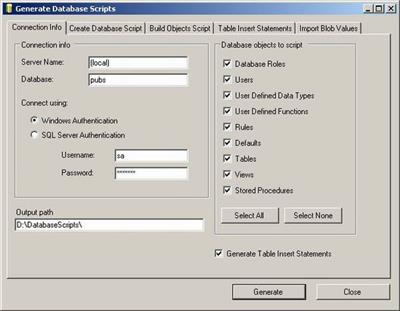
- #Dbschema generate sql how to#
- #Dbschema generate sql install#
- #Dbschema generate sql generator#
- #Dbschema generate sql mac#
Let’s make that happen with the northwind database using DbSchema’s wizard.Ĭheck the appropriate boxes and click “Ok.” That’s it! As you can see from the screenshot below, we now have an ER diagram of the northwind database running on a 3 node YuagbyteDB cluster. Once you are connected, you’ll get prompted to reverse engineer a database. Step 5: Test Drive DBSchema With YugabyteDB this is YugabyteDB’s default userĬlick the “connect” button and you are now ready to start exploring DbSchema.
#Dbschema generate sql mac#
In the following section, we’ll cover the basic steps for getting up and running in just a few minutes with a local 3 node cluster on your Mac laptop.
#Dbschema generate sql how to#
Although for the purposes of this blog post we’ll be installing everything on a macOS, both YugabyteDB and Dbschema support most major operating systems.įor complete instructions on how to get up and running on a variety of platforms including prerequisites, check out our Quickstart Guide.
#Dbschema generate sql install#
Ok, let’s dive in and get Dbschema installed and connected to a YugabyteDB cluster! Step 1: Install a Local YugabyteDB Clusterīefore we get into DbSchema, you’ll need to setup YugabyteDB and install a sample database. This enables you to open and modify the schema offline, then synchronize it when you connect to the database. Schema Synchronization - DbSchema is using its own image of the schema saved to the project file.Save the schema structure to the project file and you can reopen it without database connection. Connect to any Database and Reverse Engineer the Schema - Start a new project by reverse engineering the schema.Visual Query Builder - Build SQL Queries visually, without having to write any line of code.A predefined repository of patterns will help you find the best data pattern for each column.
#Dbschema generate sql generator#

Interactive Layouts - Divide complex schemas into separate layouts (groups of tables) for a better representation of the database.You may also like: Continuous Integration and Continuous Delivery for Database Changes What Is DbSchema?ĭbSchema boasts many of the must-have features you’d expect from a database GUI tool including: Yugabyte’s SQL API (YSQL) is PostgreSQL wire compatible.

What’s YugabyteDB? It is an open source, high-performance distributed SQL database built on a scalable and fault-tolerant design inspired by Google Spanner. In this post, we’ll show you how to get DbSchema connected to a YugabyteDB cluster so you can start reverse-engineering schemas, edit ER diagrams, browse data, visually build queries and even sync schemas. And because YugabyteDB is PostgreSQL compatible, getting DBSchema to work with a distributed SQL database is relatively simple. DbSchema is a well-rounded, visual database tool that supports over 40 databases from a single interface. If you’re a database developer, you know the time-saving value of being able to visually design, document and query SQL and NoSQL databases from a single UI.


 0 kommentar(er)
0 kommentar(er)
